It’s easy to feel intimidated walking into a CrossFit gym for the first time - I definitely was when I started 11 years ago.
After all, CrossFit is synonymous with hardcore athletes and gruelling workouts.
But the truth is, CrossFit is for everyone. The community is incredibly supportive, and the workouts can be scaled to match any fitness level.
If you’re a CrossFit beginner, here are six essential movements you need to master as a starting point. With practice, you’ll be nailing them like a pro in no time.
1. The Air Squat
Movement one is the air squat, which is probably the most fundamental of all fitness movements.
That’s because most of us do it every single day. When you sit in a chair, go to the bathroom, or get in and out of your car, you’re squatting.
That means that if you learn how to squat properly, not only are you going to begin squatting with heavier weights, the movement and technique will translate into other areas of your life, too - that’s why we call CrossFit functional fitness.
So what are the basics you need to remember when squatting?
First off, start out with your feet shoulder-width apart (or slightly outside of your shoulders).
Your toes should either be pointing directly forward or slightly outward - whatever position feels most comfortable.
Lots of people say you have to squat in one particular way, but that’s just not true. But as a general rule, the feet go under (or slightly outside) the shoulders with the toes slightly angled out.
Then, you’ll need to maintain a nice tight core.
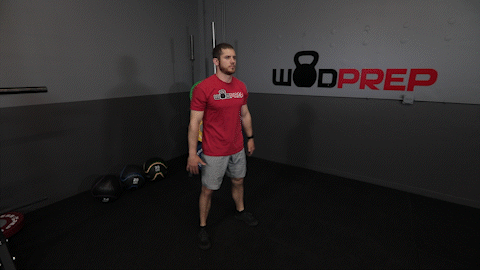
From this position, you’ll need to send your hips back slightly, kinda like you have a car door behind you with your arms full of groceries, and you're shutting the door with your butt.
From here, you’ll need to bend your knees - keeping a proud forward-facing chest - and squat downwards.
As you go down, think about driving your knees outward to avoid them caving in.
The goal here is to get low enough so that your hip crease sits below the top of your knee - that’s what we call a full-depth squat.
There are a load of different versions of the squat, but the air squat is a great move to perfect before adding weights and more challenging variations like back squats, front squats, thrusters, wall balls and overhead squats.
2. The Press
The press is another movement that every CrossFit beginner should know.
Again, this is a movement that most of us do every day without even realizing it.
Every time you reach to put groceries away at the top of the refrigerator or pantry or to grab something and pull it down, you’re doing a press.
The one I’m going to talk about here is known as a strict press or shoulder press.
To do it, All you need to get started is a barbell, PVC pipe or whatever else you want to use.
Then all you have to do is hold it on your shoulders and press it overhead.
Seems pretty simple, right?
But there are some nuances to the movement that you need to factor in, so let’s break the movement down into more detail.
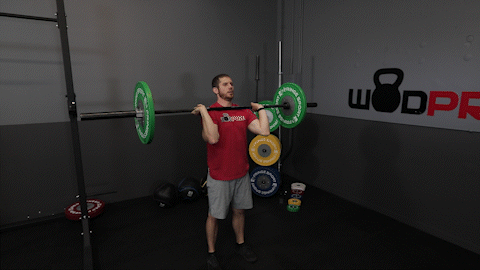
As you get into your stance, your feet should be directly under (or slightly wider than) your hips. You should feel like you’re in a nice, stable position where you’re not going to fall over.
Like everything we do in functional fitness or CrossFit, you’ll need to maintain a tight core and proud chest to help stabilize the movement - so put those shoulders back and really brace that core.
The weights should be level with your shoulders, and as you hold your bar there, your elbows need to be directly under the bar or slightly in front of the bar that you’re pressing overhead.
As you lift the bar past your head, you need to tuck your chin back to get your head out of the way.
Next, press directly overhead. As you get into your overhead position, your elbows should be fully locked out with the bar centered over your body.
If it’s too far forward, it’s going to fall down. If it’s too far back, it’s an overextension that puts your lower back at risk of injury - so try to keep it all in alignment with the rest of your body.
Once you’ve perfected the strict press, you can begin to build in more complex movements, including push press, push jerk, split jerk and thruster.
You can also start adding in weights like barbells and kettlebells. With a kettlebell, you can also take it from a two-hand lift to a one-hand lift to help you develop strength and control in one arm.
For a one-arm lift, get into the same position, and again, lift directly overhead. To keep the weight centered over your body, it’s a good idea to put the arm you’re not lifting straight out to the side.
3. The Deadlift
Movement number three, the deadlift, is another movement that we do every single day we live our lives.
A deadlift is simply picking some sort of weight up off the ground - that's it.
So imagine you drop a pencil, or you pick up your dog to hug them (something I do every day). When I do that, I'm lifting something up and standing with it.
So what does it look like in practice?
Again, you can use a barbell, a PVC pipe or whatever else you have that you can use to practise.
The bar needs to start at a mid-shin level. From there, all you need to do is stand up. To do multiple reps, go back down to the starting position and repeat.
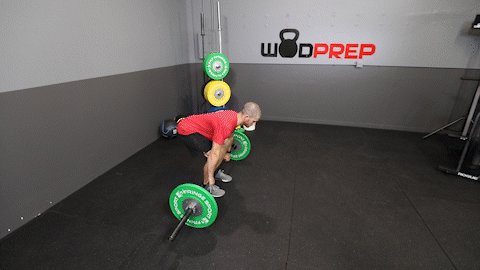
If you can develop your deadlift to get really strong, then it can lead to many more complicated and fun movements like cleans and snatches because the deadlift is a part of a lot of different movements inside the gym.
So let's quickly go over a couple of quick tips to cover the fundamentals.
When we're setting up for a deadlift, start with your feet (generally speaking) pointed forward and placed underneath your hips.
So whereas the squat was outside the hips or under the shoulders, the deadlift is pretty much always just going to be underneath the hips. You could do a sumo deadlift, but it's not as common.
As you take the bar down towards the middle of your shins, keep the shins relatively vertical.
Rather than bending over with a rounded back, you’ll need to keep your core tight with your spine in a neutral position so that it’s straight enough to balance a PVC pipe along your spine.
Then, as you lift up, drive through your feet, pressing them into the ground. When you’re standing, make sure you’re in a straight-up position (not leaning back), squeezing your butt cheeks, locking out your hips all the way - and that’s how you do a standard deadlift.
Like the press, you can do deadlifts using a single weight like a kettlebell and just one arm once you’re comfortable with the basic deadlift movement.
4. The Pull-Up
Movement number four that you need to learn when you're starting to do CrossFit is the pull-up.
This is one of the best demonstrations of upper body strength - believe it or not, there are actually lots of life insurance policies that somehow determine the rate that they give you based on how many pull-ups you can do.
This is because to do a pull-up, you have to have a good combination of strength to weight ratio.
So pull-ups can feel pretty intimidating for beginners. After all, CrossFit pull-ups come in a wide variety of crazy variations.
But before you freak out, we’re sticking to a simple, strict pull-up in this article.
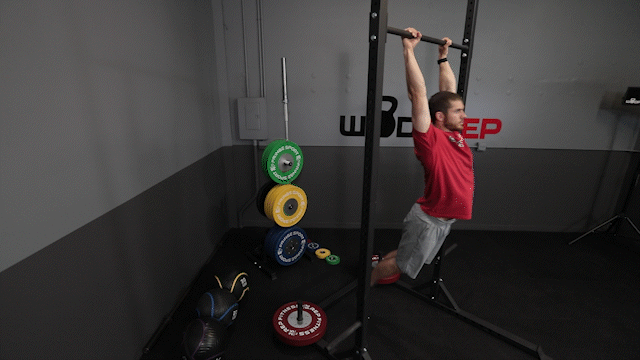
Take It To The Next Level With This Kipping Pull Up
For a strict pull-up, all you need to do is to go from having your arms completely locked out to getting your chin above the bar.
If you can do that, then you are in a great position to start learning more complicated pull-up variations - but before you get to the next level, it’s important to master the pull-up in its most basic form.
Here are the fundamentals:
Start with your hands shoulder-width (or slightly wider) apart
Keep your core nice and tight
Keep your feet slightly in front of your body
From here, all you need to do is pull yourself up.
If you can’t do this straight away, don’t worry, there’s a simple method to make it slightly easier - all you’ll need is an assistance band.
To do a pull-up this way, take your band, wrap it around the bar that you're pulling from, step into it, and then pull up using the same technique.
This is a great starting point for those who want to get the stimulus and the feel of a pull-up but don’t yet have the strength to get there yet.
If you’re looking to improve your pull-ups, check out our free pull-up training programmes to get you to the next level.
5. The Burpee
One of the most fundamental movements in all of CrossFit and in life, in general, is the burpee.
A burpee is simply getting on the ground and then getting back up.
This is a foundational movement that we should be able to do - if we can't lay on the ground and then get back up from it, then we're only a couple of steps away from being in an assisted living home.
So how do you do a standard burpee?
Start from a standing position
Bring your hands to the ground
Kick your legs out into a plank position
As your legs kick out, bend your arms so that your chest hits the floor
Do a modified pushup to get yourself back up
Kick your legs back to the starting position
Lift your hands off the ground to get into a standing position
As you stand, jump and clap your hands above your head
Repeat
It’s that simple.
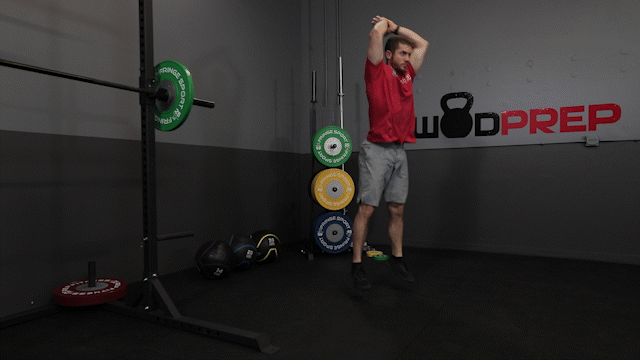
If you know the burpee, then when you go to a CrossFit or functional fitness gym, you're gonna be able to do all kinds of different variations. There are burpees over the bar, burpees over the box, reverse burpees and more.
If you want to learn how to do all the different techniques, we have a fantastic full course called burpee blueprint.
Bonus Move: The Jump Rope
The sixth and final movement you need to master as a CrossFit beginner is simply jumping rope.
The jump rope is ideal for building cardiovascular endurance alongside coordination.
It’s pretty standard that I’ll see someone who’s really strong, but as soon as they have a jump rope in their hands, all their strength and skills go out the window because they lack coordination.
There are a couple of variations that you can start practicing.
It’s a good idea to start with the single under (the rope goes around once for every jump).
When you can do single unders comfortably, try challenging yourself with the double under (the rope goes around twice for every jump).
In CrossFit specifically, you'll find double unders are the primary form of jumping rope - but there are plenty of other variations you can try as well.
If you’re struggling to transition from singles to doubles, try doing a combination of the both, for example, where you do two singles followed by a double.
This will really help you to improve and control your breathing, cardiovascular endurance, and coordination.
Practice these six moves for CrossFit beginners, and you’ll get to the next level in no time.
If you're someone who's looking to develop your CrossFit skills and learn some more complex skills that we haven't touched on, then make sure to check out all the CrossFit courses we have on offer at WODprep Academy.
